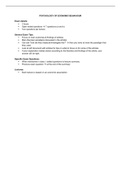Samenvatting
2023 Updated Summary of Psychology of Economic Behaviour (6464EL15)
I got a 9.0 with these summaries. Check when buying older summaries - the articles have changed in 2023! Complete summary of updated 2023 articles, lecture slides, personal lecture notes, exam tips and possible questions as given by Eric in class.
[Meer zien]




